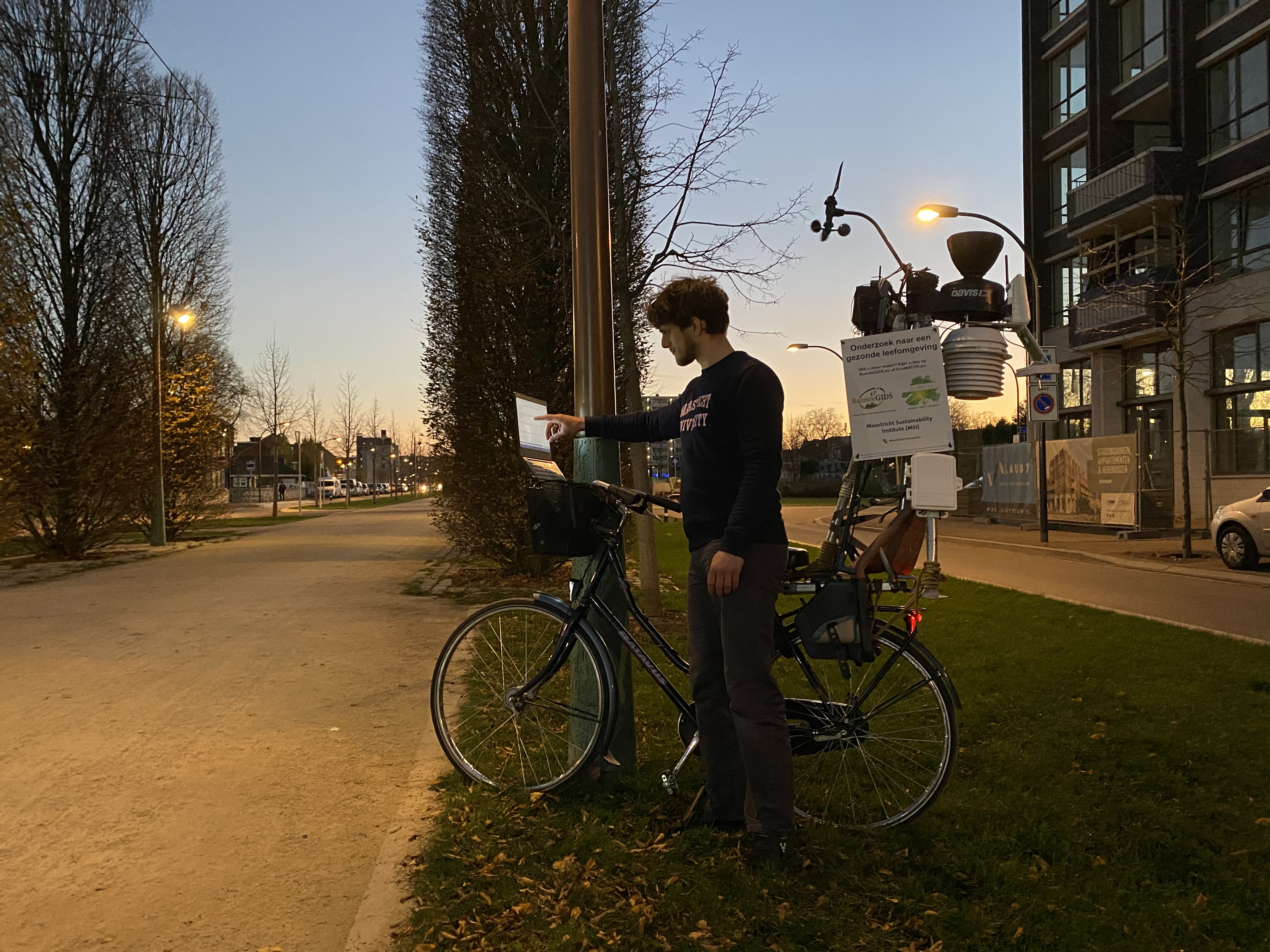On the move with the Urban Hotspotter measurement bike
You may have seen him passing by on the Groene Loper (a greenway in Maastricht)—researcher Bram Oosterbroek on his Urban Hotspotter measurement bike. It is certainly eye-catching, with measuring instruments on the back and a laptop in a basket on the handlebar. 'I study the health effects of spatial planning', he says. He is happy to explain more.


Bram Oosterbroek on the move with his measuring bike
Our living environment
Starting with spatial planning. What is that? 'We are now on the Groene Loper [a greenway in Maastricht], but there used to be a highway here. There are also, of course, buildings, benches and a climbing frame.' The public space, the living environment in which you and I find ourselves every day when we get out and about, has been designed or set up—by the municipality, housing corporations, as well as by the people themselves. Bram: 'And I’m curious about the effects of this on our health. Do we exercise more or less, does the environment invite people to come together, do they use the Groene Loper to relax?' Bram uses his unique bicycle for this research.
To measure is to know
From his home on the Statensingel, he regularly cycles in the direction of the Groene Loper. 'First of all, the equipment measures the air quality and the heat island effect.' He also has to explain the latter. 'During a heat wave, it's usually warmer in the centre of a city than in the outlying areas. That's because the city has more buildings and less green space. This is called the heat island effect.' Bram emphasises that the bicycle is still in the pilot phase, but he can already share a bit about the findings. 'The initial measurements show that during heat waves it can be up to 4 to 5 degrees warmer in the centre of Maastricht than outside the city. On the Groene Loper, on the other hand, it is roughly one degree cooler than in the city centre. That may seem like a small difference, but during a heat wave it can affect your sleep. What I also like to hear is that the residents appreciate the fact that measurements are actually taken at the place where they live. That's the advantage of the bicycle; you can get to places that cars, for instance, can't.' But he does more.
In conversation
Bram is regularly approached by passers-by. He then has a conversation with them and asks them questions about health. The initial experiences have been successful. He speaks to all kinds of people. Young, old, with more or less education, and from all kinds of cultural backgrounds. 'Recently, some kids who were about 10 years old came to ask me what the measurement bike did. They came from Wyckerpoort-North and Nazareth but liked to play in the Leeuwenparkje. See, that’s interesting to me. Why do they travel those kilometres? It turns out that they especially like the tyre swing and buy candy at the supermarket. That's how you discover the surprising ways in which people make use of the place where they live.' He also observes people’s behaviour and will monitor places.
Looking for opportunities
Which places that will be, will be determined by the people involved in the Groene Loper—local residents, policymakers and professionals. 'As part of the project RuimteGIDS, which my research falls under, these people form a learning community. Together, they look for opportunities for the neighbourhood. Where can we join forces? They have already identified some of the places that are most important to them for health, called "hotspots". Because of corona, we haven’t yet come together to brainstorm about the opportunities, but I can also measure that in the future.'
Do you live near the Groene Loper and are you interested? Then check out the website of RuimteGIDS (in Dutch) or talk to Bram when he cycles past again.
Original article (in Dutch): https://www.mijngroeneloper.nl/nieuws/nieuws-archief/op-pad-met-de-urban-hotspotter-meetfiets